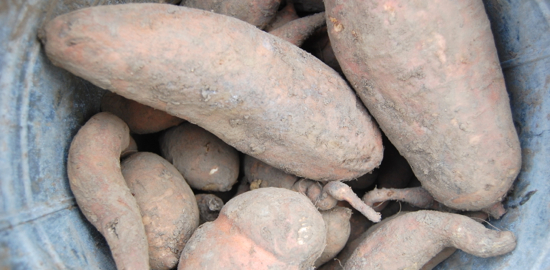Er, you have to “cure” sweet potatoes?

I’ve received a couple of questions along those lines the last two days. The answer is yes, but only if you’ve grown them yourself. Grocery store sweet potatoes are cured before they get to market. But what is this mysterious “curing”? What do sweet potatoes need to be cured of? Good question. Basically curing is a process by which the potatoes are stored for 10 days or so at a temperature of about 85-90 degrees Fahrenheit. That initiates the process by which the potato’s starches convert to sugars, and gives them their characteristic flavor.
That’s not easy to do when you live in a temperate zone where the temperature outside is 45 degrees Fahrenheit in October and your house is about 70. We happen to have friends with a greenhouse that stays about 85 all year round. Very handy in this case, since uncured sweet potatoes, while they can be used for pies that employ added sugar, aren’t very flavorful nor do they bake up especially well.
Once cured the potatoes need to be stored in a cool place at about 60 degrees for maximum shelf life…six months if all goes well!
Are they yellowish inside before they are cured?
Hey LML!
Yes, ours were orange on the. Inside when we dug them up, and didn’t seems to change color after their time in the hot house. But they’re extremely sweet now!
– Joe
Oooo! Fussy little buggers, aren’t they? Makes you wonder how they caught on as crops before things like reliable heating and refrigeration.
They really are fussy…hot, then cool. More on these finicky things tomorrow!
– Joe
What about the ones I get from my CSA basket ? They come coated with dirt. Do you think the CSA farmer cured them ?
My assumption would be that they are cured, Timmy. I didn’t clean the dirt off of mine before curing them…just dumped them in buckets! 😉
– Joe
Thanks for addressing this, Joe. So many edible vegetables each with such different growing requirements and handling after harvest. No wonder the pilgrims gave thanks!
Amen, Susan!
– Joe
These look like what we call “orange kumara” in New Zealand, we also have a yellow one with purple skin and a gold one as well. I don’t like the texture of the orange one, the yellow with purple skin has a mealier texture and a more distinctive flavour (I think).
Hey Annemarie!
There’s debate here in the States over which best, the drier-fleshed or the wetter. For us it’s mostly a question of texture since the flavors are about the same, at least in my opinion. There are the wetter variety which are best for pies and custards. The drier make better fries!
Cheers,
– Joe
Hi Joe,
Which probably explains my preference for the drier variety. Here they are usually used to accompany a roast meat meal, made into fries, or mashed, or bake jacketed and served with sour cream (and often sweet chilli sauce and maybe a touch of coriander, ohhhhhhh so good)…so savoury applications. Sweet potato pie is not something most Kiwi’s are familiar with, although I see your recipe has bourbon in it, so I could probably persuade the Mr.
Very interesting Annemarie. If you decide to try it please let me know what you think. If you have ever had pumpkin pie you will find this quite similar.
Cheers,
– Joe
Hi Joe,
I never knew these had to be cured. We only grown them once and we didn’t even know how long we had to wait before we reaped them. It was all trial and error. But now i understand why sometimes when i buy it in the market my mummy complains that they are not good cause they taste ‘brackish’. hmmmmm. Thank you. 🙂
Melody
There’s some discussion and data on starch conversion in sweet potatoes at Serious Eats (plus a Harold McGee quote), which makes me wonder if further par-cooking the sweet potatoes at ~150°F before making pie would improve the flavor even more (and require reducing the amount of sugar added).
Fascinating, Jim! Thanks very much. I’ll employ the sous vide this week, Mrs. Pastry will be very pleased indeed!
Cheers,
– Joe